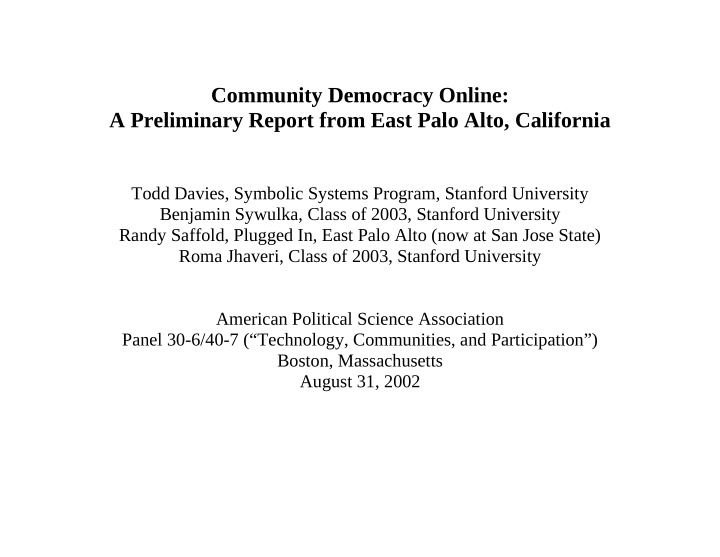



Community Democracy Online: A Preliminary Report from East Palo Alto, California Todd Davies, Symbolic Systems Program, Stanford University Benjamin Sywulka, Class of 2003, Stanford University Randy Saffold, Plugged In, East Palo Alto (now at San Jose State) Roma Jhaveri, Class of 2003, Stanford University American Political Science Association Panel 30-6/40-7 (“Technology, Communities, and Participation”) Boston, Massachusetts August 31, 2002
East Palo Alto: By the Numbers Population ~ 30,000 59% Hispanic/Latino (84% from Mexico) 23-24% Black/African American (down from 60% in 1980) 8-9% Pacific Islander (esp Tongan, Samoan, Fijian) 7% White alone (Anglo) 2-3% Asian Some facts: 81% of area school children qualify for lunch subsides 52% of residents over 25 never finished high school 65% do not speak English at home (Spanish 54%, Tongan 6%) more renters than in neighboring areas, living in crowded conditions higher percentage of families, lower divorce rate than surrounding area similar rate of transience as surrounding area, but more renters (57%) One-third of Latino residents report having home Internet access We estimate less than half of all residents have home Internet access
East Palo Alto: Community Characteristics City overall: culturally vibrant, strong sense of community ethnic communities capable of uniting (e.g. around juvenile justice) strong emphasis on word-of-mouth and face-to-face interaction underlying distrust of city leaders, including orgs with resources Ethnic communities: Latino - younger on average, generation gap in outlook African American - older on average, gap between established families/leaders and other African Americans Pacific Islander - younger on average, gap on immigration concerns Anglo - population increasing, more well-off, disproportionate share of leadership (mayor and city manager are both white) Asian and other – small communities, visible among small business owners/store managers
East Palo Alto: Some Recent History Unincorporated until 1983, tax-producing land gobbled up by surrounding cities Dramatic reduction in murders: 42 (highest rate in U.S.) in 1992; only 1 in 1999 Wave of commercial development in late 1990s brought jobs and tax money to the city, but also some displacement Recent, well-reported scandals involving city officials reflect and contribute to an atmosphere of distrust
East Palo Alto: Resource Spike (1999-2002) Tax base City budget for 2001: ~$13 million / year ($440 per resident) Big increase from $4 million / year (1995) Still low compared to neighboring Palo Alto ($2150 per resident, 2001) Externally funded community initiatives Neighborhood Improvement Initiative (1999-??), $1.25 million / year Digital Village initiative (2000-2003), $6 million total Intense amount of community-based planning (“death by meetings”) Many working groups, community forums, advisory boards Less than 1% of population really involved: a few score of highly involved people go to most of the meetings Key decisions made in face-to-face meetings, often little formal process (by-laws, agenda, minutes), generally no email list for group
E.P.A. Community Network – Stanford Collaboration (July 2001 - ) Community Network is part of Digital Village, includes Technology Access Points and a community web portal, EPA.Net, with online news, links, and forums Service/community-based learning Student participation funded by Stanford Study areas Language functionality and community demographics Face-to-face community meetings Online community experience Community survey related to computer usage Insider interviews
East Palo Alto: Hard Times Return (April 2002 - ) Hewlett Foundation withholds Neighborhood Improvement Initiative funds for FY 2002-2003, demanding the number of projects be reduced from 39 to 2-3, with clearer goals and evaluation criteria Internal strife afflicts Digital Village advisory board and it ceases to meet Budget shortfall hits City Government, due to loss of revenues from changed State vehicle license fee City manager resigns in scandal, questions emerge about City use of funds Silicon Valley is in recession – little money available to sustain programs without continuation funding
Our Thesis (1) Failure to invest in decision support has led to breakdowns in trust and effectiveness among groups implementing the community investment initiatives and in the City Government. (2) Given the environment in East Palo Alto, participatory community planning, involving a sufficiently broad base of residents could be done with the support of Internet-based communication to augment face-to-face decision making, but would be difficult or impossible to accomplish otherwise. (3) Social science research can play an important role in influencing the provision of funding for decision support technology, as a foundational component of grass-roots social change which is under-appreciated by sponsors and governments.
Process Failures and Their Consequences 1. An emphasis on face-to-face meetings for making important decisions in East Palo Alto disenfranchizes residents and biases outcomes. 2. Insufficiently frequent communication hampers the ability of committee members, and the public, to participate in key decisions. 3. Lack of information about relevant external events leaves meeting participants unprepared for change. 4. Self-selection of participants leads to biased decision making in groups. 5. The use of streamlined procedures for making important decisions can lead to ineffective decisions and disillusionment.
Process Failures and their Consequences (continued) 6. Face-to-face meetings put decisions in a setting that may be information-poor relative to what is needed. 7. Face-to-face meetings are often accompanied by a lack of transparency. 8. Lack of adequate decision support makes it difficult to know when and where meetings are being held, even if they would otherwise be able to and interested in attending. 9. The defects of an emphasis on face-to-face meetings, and of a lack of decision support, are more damaging in a disadvantaged community like East Palo Alto than they would be in an advantaged group, because they amplify the distrust and despair that is already highly present in the disadvantaged community
Relationships to Other Literature Community change initiatives (CCIs) The Internet and social capital Main effects versus directed research Community electronic networks Online deliberation Digital divide, access, and participation
Ideas about Future Activities (2002-2003) Immediate applications: Use of the E.PA. Community Network to make meeting information available centrally, publicizing it, and measuring impact Setting up an online forum in which city official answers residents’ questions – one has expressed willingness Next-generation application: Development of a prototype tool for online asynchronous meetings
Recommend
More recommend